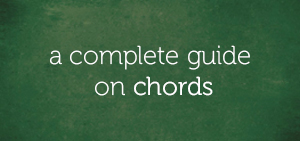In today’s lesson, we’re going to focus on how to strengthen a triad.
These days, with so much emphasis on “phat” chords and extended voicings, it is easy to overlook and disregard triads.
In fact, in my estimation, a vast majority of budding musicians have little to no appreciation for them. Don’t get me wrong… I’m only making this assertion because I used to belong to that league.
Many years ago, I disdained triads and anyone who used them and even considered them to be harmonically primitive. I suppose this was because they contain the minimal number of notes a chord can have (which is three). Therefore, I internally placed the three-note triad in the lowest class of chord, opting for the “more is better” mindset.
Another good reason was that triads sound very basic as opposed to extended chords such as the sevenths, ninths, and altered chords. Being a growing musician, I couldn’t understand why I should settle for triads when bigger chords exist.
Truth be told, you can never outgrow the triad. Instead, you’ll keep discovering several ways to make it sound better. In a previous post, I explained how to make a triad spicier without making it jazzier.
“How can triads [as weak as they ‘seem’] be strengthened?”
Today, I am going to show you, step-by-step, how you can strengthen a triad.
This has little to do with adding any extra notes. It entails what you least expect – inversion.
Triads sound better when inverted. Although, the augmented and diminished triads are an exception to this rule, you can make major and minor triads sound better by simply inverting them.
Inversion of Triads
Inversion affords us the opportunity of rearranging the order of the notes of a triad.
There are two common styles of inversion:
- Keyboard style
- Choral style
In this post, we’ll be looking at “inversion according to the keyboard style” and how we can strengthen a triad with it.
Inversion is the rearrangement of the notes of a chord. This rearrangement is done using the octave transposition technique.
Transposition literally means TRANSfer of POSITION. The octave transposition technique helps you transfer a note from its current position to a higher or lower octave.
Let’s look at two approaches to octave transposition.
#1 – Octave Transposition of the lowest chord tone
Given the C major triad:
…where the notes are C-E-G, and the lowest sounding note is C, an octave transposition of C (the lowest note) will produce E-G-C:
This is still a C major triad. However, considering that its notes are rearranged, the C major triad is said to be inverted. This rearrangement is called the first inversion.
#2 – Octave Transposition of the highest chord tone
Using the same C major triad:
…where the notes are C-E-G, and the highest sounding note is G, an octave transposition of G (the highest note) will produce G-C-E:
A triad is a chord of three notes and the number of notes a chord has is equal to the number of ways it can be played (Jermaine Griggs). This means that there are three ways of playing a triad.
#1 – Root Position
During chord formation, the root of a triad is usually the lowest note. Playing a triad with the root as the lowest note produces the root position triad:
#2 – First Inversion
In this rearrangement, the root is the highest sounding note while the third is on the bottom.
#3 – Second Inversion
In this rearrangement, the root is in between the fifth and third. The fifth is on the bottom.
“Can I Show You What Inverted Triads Possess That Root Position Triads Don’t?”
The first and second inversion triads sound stronger than the root position triad because by virtue of inversion, a triad upgrades in the size and quality of interval between chord tones.
In the first inversion triad:
…the interval between G and C is a fourth. Also in the second inversion:
…the interval between G and C is a fourth.
As opposed to the first and second inversions, there are no fourths in the root position triad:
…and this is one reason why the root position triad does not sound as strong as inverted triads.
Final Words
It’s common for people to ask “Between the first and second inversion triad, which sounds stronger?”.
Well, that’s debatable. Here are two schools of thought as regarding which triad is stronger.
Perspective #1 – “First Inversion Triad Sounds Stronger”
There are music scholars and theorists who argue that the first inversion triad sounds stronger.
One of the strongest reasons to support their assertion is that the root of the triad is the highest sounding note (aka – “melody note”) in the first inversion triad and this is true.
In the first inversion of C:
…I’m not the only observing that the root note (C):
…is the highest sounding note.
Perspective #2 – “Second Inversion Triad Sounds Stronger”
In classical music, triads can be broken down into top and bottom intervals.
When a triad has a fourth in the bottom and a third above, it is considered dissonant.
The second inversion triad:
…belongs to this category of triads.
The bottom interval is G-C:
…a fourth, while the top interval is C-E:
…a third.
It is the dissonance of the second inversion triad that is the rationale behind this school of thought. In a time where dissonance is now embraced, this becomes a positive.
The goal of this post is not to resolve the controversy between both schools of thought, but rather to show you how to strengthen a triad.
Whichever school of thought you belong to is okay. This is because both inversions, if played side by side, sound better than root position triads and this is because both of them have fourths.
Chuku Onyemachi
Latest posts by Chuku Onyemachi (see all)
- The Formation Of Diminished Seventh Chords Used To Be Challenging Until I Did This
- How To Form Seventh Chords In Two Shakes Of A Dog’s Tail Using Third Intervals And The Circle Of Fifths Chart
- I Played The 13sus4 Chord And This Happened…
- How To Build Seventh Chords Like An Architect Using “Foundation And Structure” Concept
- This 4-Week Plan Will Help You Master All The Major Scales







Comments on this entry are closed.